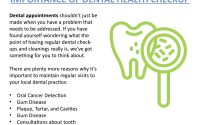Gum Disease: Signs, Prevention, and Treatment
Introduction
Gum disease, also known as periodontal disease, is a common oral health condition that affects the gums and supporting structures of the teeth. It is caused by bacteria in plaque, a sticky film that forms on the teeth. If left untreated, gum disease can lead to tooth loss and other serious health complications. In this blog post, we will explore the signs, prevention methods, and treatment options for gum disease.
What is Gum Disease?
Gum disease, also known as periodontal disease, is a common oral health condition that affects the gums and supporting structures of the teeth. It is caused by the buildup of plaque, a sticky film of bacteria that forms on the teeth.
Signs of Gum Disease
Gum disease can manifest in various ways, and it is important to be aware of the signs and symptoms. Some common signs of gum disease include:
1. Red, swollen, or tender gums
Gums that appear red, swollen, or feel tender to the touch may indicate the presence of gum disease. Healthy gums should be pink and firm.
2. Bleeding gums
Bleeding gums, especially during brushing or flossing, can be a sign of gum disease. It is important not to ignore this symptom as it may indicate an underlying issue.
3. Receding gums
Gum disease can cause the gums to recede or pull away from the teeth, exposing the roots. This can lead to tooth sensitivity and an increased risk of tooth decay.
4. Persistent bad breath
Chronic bad breath, also known as halitosis, can be a sign of gum disease. The bacteria in the mouth that cause gum disease can produce foul-smelling gases.
5. Loose or shifting teeth
As gum disease progresses, it can cause the teeth to become loose or shift in position. This can affect the bite and overall oral health.
Prevention of Gum Disease
Preventing gum disease is essential for maintaining good oral health. Here are some preventive measures you can take:
1. Brush and floss regularly
Brushing your teeth at least twice a day and flossing daily helps remove plaque and prevent its buildup. Use a soft-bristled toothbrush and fluoride toothpaste for effective cleaning.
2. Maintain a healthy diet
Avoid sugary and acidic foods that can contribute to plaque formation. Instead, opt for a balanced diet.
Summary
Gum disease is a prevalent oral health issue that can have serious consequences if not addressed promptly. It is characterized by inflammation and infection of the gums, which can lead to tooth loss and other health problems. The signs of gum disease include red, swollen, or bleeding gums, persistent bad breath, receding gums, and loose teeth. To prevent gum disease, it is essential to maintain good oral hygiene practices such as regular brushing, flossing, and professional dental cleanings. Additionally, avoiding tobacco use, eating a balanced diet, and managing stress can contribute to gum disease prevention. If gum disease is diagnosed, treatment options may include deep cleaning procedures, med official site ication, or in severe cases, surgery. Early detection and intervention are crucial in managing gum disease effectively and preserving oral health.
- Q: What are the signs of gum disease?
- A: Signs of gum disease include red, swollen, or tender gums, bleeding while brushing or flossing, persistent bad breath, receding gums, and loose or shifting teeth.
- Q: How can I prevent gum disease?
- A: To prevent gum disease, it is important to maintain good oral hygiene by brushing your teeth twice a day, flossing daily, using mouthwash, and visiting your dentist regularly for check-ups and cleanings. Avoid tobacco use and maintain a healthy diet.
- Q: What are the treatment options for gum disease?
- A: Treatment for gum disease depends on the severity of the condition. It may include professional dental cleaning, scaling and root planing, medication, or in severe cases, surgery. Your dentist will determine the most appropriate treatment plan for you.

Welcome to my website! My name is Spencer Rossi, and I am a dedicated and passionate dental assistant with extensive experience in general dentistry, braces, aligners, cosmetic dentistry, and pediatric dentistry. I am thrilled to have the opportunity to share my knowledge and expertise with you through this platform.




